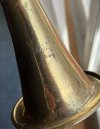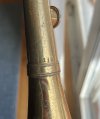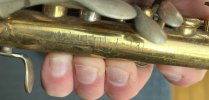I've just come into possession of this (very?) old Noblet metal clarinet. It's in pretty bad shape. I'm not necessarily interested in making it playable, just trying to find out when it was made!
The clarinet came to me without a case. It's tarnished, missing a pad on the E-flat sliver key, lots of pads are in bad shape, there are various dents, bent springs, and the whole body is slightly bent!
Anyway… here's what I can see on it. The Noblet logo is stamped on the bell inside an oval/rounded-square shape. Someone hand-etched "Mpls Bd of Ed" on the bell, so obviously this was a school instrument.
There are two numbers. Stamped on the back of the body just above the bell is what I believe is the (very low) serial number: 138.
Up on the side of the body just above the thumb rest, is another hand-etched number: MNO2711-1-131. Model number 27…?
Any insight would be greatly appreciated!
The clarinet came to me without a case. It's tarnished, missing a pad on the E-flat sliver key, lots of pads are in bad shape, there are various dents, bent springs, and the whole body is slightly bent!
Anyway… here's what I can see on it. The Noblet logo is stamped on the bell inside an oval/rounded-square shape. Someone hand-etched "Mpls Bd of Ed" on the bell, so obviously this was a school instrument.
There are two numbers. Stamped on the back of the body just above the bell is what I believe is the (very low) serial number: 138.
Up on the side of the body just above the thumb rest, is another hand-etched number: MNO2711-1-131. Model number 27…?
Any insight would be greatly appreciated!





